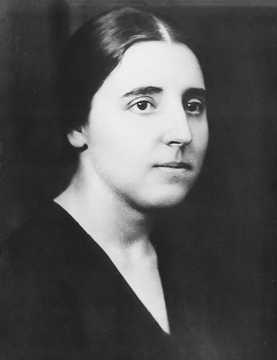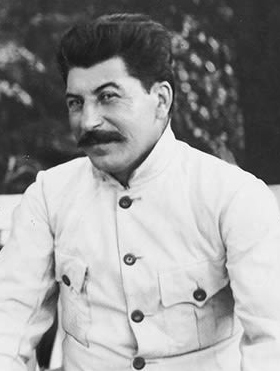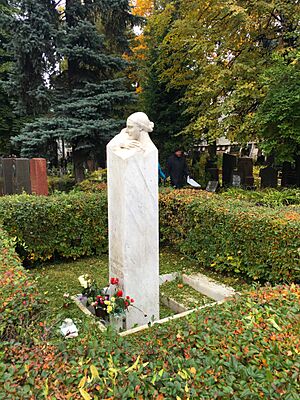Nadezhda Alliluyeva facts for kids
Quick facts for kids
Nadezhda Alliluyeva
|
|
|---|---|
| Надежда Аллилуева | |
 |
|
| Born | 22 September [O.S. 9 September] 1901 Baku, Baku Governorate, Caucasus Viceroyalty, Russian Empire
|
| Died | 7 November 1932 (aged 31) Moscow, Russian SFSR, Soviet Union
|
| Resting place | Novodevichy Cemetery, Moscow |
| Nationality | Soviet |
| Other names | Nadezhda Stalina |
| Occupation |
|
| Spouse(s) | |
| Children |
|
Nadezhda Sergeyevna Alliluyeva (Russian: Надежда Сергеевна Аллилуева; born 22 September 1901 – died 9 November 1932) was the second wife of Joseph Stalin. She was born in Baku and grew up in Saint Petersburg. Her father was a friend of Stalin and a fellow revolutionary. Nadezhda knew Stalin from a young age. She married him when she was 17. They had two children together.
Nadezhda worked as a secretary for important Bolshevik leaders, including Vladimir Lenin and Stalin. Later, she went to the Industrial Academy in Moscow. There, she studied synthetic fibres to become an engineer. Nadezhda had some health problems. These issues, along with difficulties in her marriage, led to frequent arguments with Stalin. She reportedly thought about leaving him several times. After one argument, she died suddenly on the morning of 9 November 1932.
Contents
Early Life and Family
Nadezhda's Family Background
Nadezhda Alliluyeva's father, Sergei Alliluyev (1866–1945), came from a farming family in Russia. He moved to the Caucasus region. There, he worked as an electrician for the railway. This job showed him the tough working conditions in the Russian Empire. Sergei's grandmother was Romani. His granddaughter, Svetlana, said this gave the Alliluyevs their "southern, somewhat exotic features" and "black eyes."
Sergei joined the Russian Social Democratic Labour Party (RSDLP) in 1898. This was a revolutionary group. He became active in workers' study groups. Through these groups, he met Mikhail Kalinin, a main organizer of the party in the Caucasus. Sergei was arrested and sent away to Siberia once. But by 1902, he was back in the Caucasus. In 1904, he met Ioseb Jughashvili, who later became known as Joseph Stalin. They met while moving a printing machine. Nadezhda's godfather was Avel Yenukidze. He was an old Bolshevik and a friend of Stalin.
Nadezhda's mother, Olga Fedotenko (1877–1951), was the youngest of nine children. Her parents were Evgeni Fedotenko and Magdalena Eicholz. Nadezhda's daughter Svetlana wrote that Evgeni had Ukrainian family on his father's side. His mother was Georgian, and he spoke Georgian at home. Magdalena came from a family of German settlers. She spoke German and Georgian at home. Olga's father wanted her to marry a friend's son. But she refused and left home at 14. She went to live with Sergei in Tiflis.
Growing Up and Meeting Stalin

Nadezhda Alliluyeva was born in Baku on 22 September 1901. She was the youngest of four children. Her older siblings were Anna, Fyodor, and Pavel. Her family moved to Moscow in 1904. They returned to Baku by 1906. In 1907, to avoid arrest, Sergei moved the family to Saint Petersburg. They stayed there for many years.
The Alliluyev family often helped hide members of the Bolsheviks. This was a Russian revolutionary group. They even hid Vladimir Lenin at their home during the July Days of 1917. This made Nadezhda's support for the Bolsheviks even stronger. After Lenin left Russia in August 1917, Stalin arrived. He had known Nadezhda since she was a child. It is said he saved her from drowning when they were both in Baku. They had not seen each other for many years. Over that summer, they became very close.
Nadezhda and Stalin married in February or March 1919. Stalin was 40 years old. He was a widower and had one son, Yakov. Yakov was born in 1907 to Stalin's first wife, Kato Svanidze, who died of typhus that same year. There was no wedding ceremony for Nadezhda and Stalin. Bolsheviks did not approve of religious customs.
Life and Work
Nadezhda's Professional Path
The Bolsheviks took power in Russia in November 1917. This led to the Russian Civil War. In 1918, Nadezhda and Stalin moved to Moscow. Moscow became the new capital. They lived in the Amusement Palace inside the Kremlin. They had separate rooms there.
Stalin made Nadezhda a secretary at the People's Commissariat for Nationalities. He was the head of this department. In May, he took her and her brother Fyodor to Tsaritsyn. The Bolsheviks were fighting the White Army there. Nadezhda did not stay long and returned to Moscow. Stalin was often away fighting in the Civil War. By 1921, the Civil War ended. In 1922, the Soviet Union was formed, with Lenin as the main leader.
Nadezhda did not want to rely on Stalin. So, she changed jobs and joined Lenin's office. This reportedly bothered Stalin. He wanted his wife to quit her job and stay home. Nadezhda liked working for Lenin and his wife, Nadezhda Krupskaya. They were more understanding about her work. For example, Lenin knew Nadezhda had left school young. He forgave her for spelling mistakes.
In 1921, Nadezhda had her first child, Vasily. A few months later, she was removed from the Bolshevik Party. She found it hard to manage family life, work, and party duties. She was seen as not very interested in party life. She was allowed back into the party with help from top officials, including Lenin. Her full status was given back in 1924. Nadezhda worried that if she did not work, she would not be taken seriously. She also wanted to be skilled in any job she did. After working for Lenin, Nadezhda briefly worked for Sergo Ordzhonikidze. He was a close friend of Stalin and a senior Bolshevik. Then she worked as an assistant at the International Agrarian Institute.
Lenin died in 1924. Stalin eventually became the leader of the Soviet Union. Nadezhda was tired of her work and did not like being the "First Lady." She looked for something new to do. She was interested in education and wanted to be more involved with the party. In 1929, she joined the Industrial Academy. She studied engineering and synthetic fibres, which was a new technology. She also became more active in local party meetings.
Nadezhda used her maiden name when she enrolled. This helped her keep a low profile. It is not clear if her classmates knew who she was. But it is likely that the local party leader, Nikita Khrushchev, knew. Nadezhda often took the tram from the Kremlin to the academy. Her friend Dora Khazan, the wife of a leading Bolshevik, often joined her. At the academy, Nadezhda met students from all over the Soviet Union.
Family Life and Challenges
Nadezhda had her first child, Vasily, in 1921. She walked to the hospital to give birth. This showed a simple "Bolshevik" way of life. Her second child, a daughter named Svetlana, was born in 1926. In 1921, the family also took in Stalin's first son, Yakov Dzhugashvili. He had been living in Tiflis with his mother's relatives. Nadezhda was only six years older than Yakov. They became good friends. Around the same time, the family also took in Artyom Sergeyev. He was the son of Fyodor Sergeyev, a close friend of Stalin. Fyodor died in an accident four months after Artyom was born. Artyom was raised in the Stalin household.
Nadezhda wanted to have a career. So, she did not spend much time with her children. She hired a nanny, Alexandra Bychokova, to care for them. When Nadezhda did deal with her children, she was quite strict. Svetlana later remembered that the only letter she got from her mother scolded her for "being terribly naughty." Svetlana was only four or five at the time. Svetlana also recalled that Stalin seemed to fear only Nadezhda. Even so, Nadezhda wanted to make sure her children got a good education.
During the week, the family stayed in their Kremlin apartment. Nadezhda lived a simple life there. She managed the family's money carefully. On weekends, they often went to their country house, called a dacha, outside Moscow. Nadezhda's siblings and their families lived nearby. They often gathered together on these occasions. In the summer, Stalin would vacation along the Black Sea coast. Nadezhda often joined him. But by 1929, she would only stay a few days before returning to Moscow for her studies. Even when they were apart, they often wrote letters to each other.
According to her close friend, Polina Zhemchuzhina, Nadezhda's marriage was difficult. She and Stalin argued often. Stalin believed that Nadezhda's mother had a mental illness. Karl Pauker, who was in charge of Stalin's personal security, saw their arguments. He said Nadezhda was "like a flint." He added that Stalin was "very rough with her, but even he is afraid of her sometimes. Especially when the smile disappears from her face." Nadezhda suspected Stalin was interested in other women. However, according to Boris Bazhanov, Stalin's former secretary, "women didn't interest [Stalin]. His own woman was enough for him, and he paid scant attention to her."
Nadezhda's last years were also affected by her health. She suffered from "terrible depressions" and headaches. She reportedly thought about leaving Stalin and taking the children with her several times. In 1926, she left for a short time and moved to Leningrad. Stalin called her back, and she returned to him. Her nephew Alexander Alliluyev later claimed that Nadezhda was planning to leave Stalin again shortly before her death. But there is no clear proof of this.
Nadezhda's Death
November 1932 Events
In November 1932, Nadezhda was only a few weeks away from finishing her course at the academy. She marched in the 7 November parade. This parade celebrated the fifteenth anniversary of the October Revolution. Stalin and the children watched her from the top of Lenin's Mausoleum on Red Square. After the parade, Nadezhda complained of a headache. The children went to their dacha outside the city. Nadezhda returned to their home in the Kremlin.
The next evening, Nadezhda and Stalin went to a dinner. It was hosted at the Kremlin apartment of Kliment Voroshilov. He was a close friend of Stalin and a member of the Politburo. The dinner was also to celebrate the Revolution. Nadezhda usually dressed simply, in a style that fit Bolshevik ideas. But she dressed up for this special occasion. Many high-ranking Bolsheviks and their spouses were there. Nadezhda and Stalin began to argue. This was not unusual at these gatherings. Some people have suggested that Stalin was flirting with another woman there. There was also talk that he had been with a hairdresser who worked in the Kremlin.
Things got worse between them. It is said that when Stalin "toasted the destruction of the Enemies of the State," he saw Nadezhda did not raise her glass. He became annoyed. Stalin supposedly threw something at her. It was described as an orange peel, a cigarette butt, or a piece of bread. He did this to get her attention. Then he called out to her. This made Nadezhda even angrier. She suddenly left the dinner and went outside. Her friend Zhemchuzhina followed her. The two women walked outside within the Kremlin Wall. They talked about the night's events. They agreed that Stalin was drunk. They also discussed Nadezhda's concerns about Stalin's supposed affairs. The two friends then parted ways. Nadezhda returned to her home.
The exact events after that are not clear. But sometime early in the morning of 9 November, Nadezhda died suddenly in her room.
Funeral and Aftermath
When her death was announced the next day, the cause of death was given as appendicitis. Her children were not told the true nature of her death. To keep the truth hidden, staff who worked in the Kremlin were either fired or arrested. Efforts to hide this information continued for several years. People who knew Stalin at the time said he was very upset by the event.
Pravda, the official party newspaper, announced Nadezhda's death on 10 November. This surprised many people in the Soviet Union. It was also the first public announcement that Stalin had been married. Her body was placed in an open casket. It was displayed on an upper floor of the GUM department store. This store was across from Red Square and the Kremlin. Government and party officials came to visit. But the public was not allowed.
The funeral was held on 12 November. Both Stalin and Vasily attended. Stalin took part in the procession to the cemetery. This involved a 6-kilometer (about 3.7-mile) walk from GUM to the Novodevichy Cemetery. It is not clear if he walked the whole way. In her memoirs, Svetlana claimed that Stalin never visited the grave again.
Nadezhda's death deeply affected her children and family. Her daughter Svetlana only found out the true cause of her mother's death in 1942. She read about it in an English journal article. This news shocked her. It greatly changed her relationship with Stalin. He had kept the lie for ten years. Svetlana remained distant from Stalin until he died. She took her mother's maiden name in 1957 to distance herself further from him. She later left the Soviet Union in 1967 and died in the United States in 2011.
Her son Vasily was also greatly affected. Even though Nadezhda had not spent a lot of time raising her children, she still cared about them. After her death, Stalin paid a lot of attention to Svetlana. But he mostly ignored Vasily. Vasily began to drink at a young age and died in 1962.
Nadezhda's father, Sergei, became very quiet after her death. He wrote his memories, which were published in 1946 after being heavily edited. He died of stomach cancer in 1945. Nadezhda's mother, Olga, lived until 1951. She died of a heart attack. Several of Nadezhda's relatives were arrested and imprisoned in 1940. This included her sister Anna and Anna's husband, Stanislav Redens.
Images for kids




